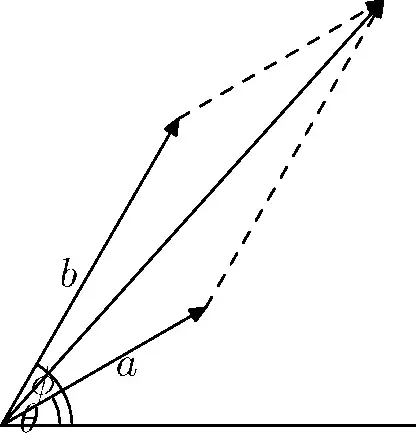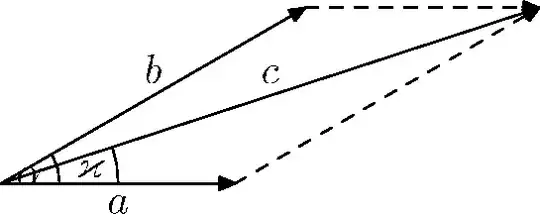I'll try to give both geometrical solution and a solution using complex numbers.
But perhaps you might have a look at Wikipedia first, their explanation is probably better than mine. (They certainly have nicer pictures.)
Wikipedia
You can find very similar formulas in Wikipedia's List of trigonometric identities. (Here is also link to the current revision of the Wikipedia article. I hope I have not made mistake somewhere and their formulas are equivalent to mine.)
A link to Phasor addition (current revision) is also given there. This Wikipedia article might help to visualize the whole thing.
Geometry
We have situation as in the following picture:

Note that the $y$-coordinates of the two vectors are precisely the values you want to add together. So we would like to know the length and the angle for the sum of these two vectors.
We simply rotate the situation. We denote $\alpha=\phi-\theta$.

We want to find the values $c$ and $\varkappa$. Once we know them, we get
$$a\sin\theta+b\sin\phi= c\sin(\theta+\varkappa).$$
For $c$ we can simply use law of cosines:
$$c^2=a^2+b^2+2ab\cos\alpha$$
(Note that the angle in the bottom triangle is $\pi-\alpha$.)
We can calculate $\varkappa$ using law of sines:
$$\frac{\sin(\pi-\alpha)}{\sin\varkappa} = \frac cb \qquad \Rightarrow \qquad \sin\varkappa=\frac{b\sin\alpha}c$$
Note that this does not determine $\varkappa$ uniquely, but you can find out whether $\varkappa>\pi/2$ or $\varkappa<\pi/2$ by checking the sign of $x$-coordinate of the sum of the two vectors, which is $a+b\cos\alpha$.
Complex numbers
We want to get
$$ae^{i\theta}+be^{i\phi}=ce^{i(\theta+\varkappa)}\tag{1}$$
(If we get such an expression then the imaginary part is a formula for sines.)
This is equivalent to
$$a+be^{i(\phi-\theta)}=ce^{i\varkappa}.\tag{2}$$
To find $c$ we simply compute the absolute value of both sides. On the LHS we get $(a+be^{i(\phi-\theta)})(a-be^{i(\phi-\theta)})=a^2+b^2+2ab\cos(\phi-\theta)$, hence
$$c^2=a^2+b^2+2ab\cos(\phi-\theta).$$
We also have
$$e^{i\varkappa}=\frac ac+\frac bce^{i(\phi-\theta)}\\
\cos\varkappa+i\sin\varkappa = \frac ac+\frac bc\cos(\phi-\theta)+i\frac bc\sin(\phi-\theta)$$
Comparing the imaginary parts yields $$\sin\varkappa=\frac bc\sin(\phi-\theta).$$
The remark that we have to do a little more to find which of the two possible values of $\varkappa$ we should choose applies here, too.

